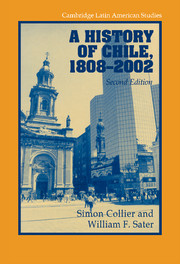Book contents
- Frontmatter
- Contents
- List of maps
- Preface to the Second Edition
- A note on geography
- CAMBRIDGE LATIN AMERICAN STUDIES
- PART I Birth of a nation-state, 1800s–1830s
- PART II The rise of a republic, 1830s–1880s
- 4 A time of progress, 1830s–1870s
- 5 The Liberal impulse, 1841–76
- 6 Crisis and war, 1876–83
- PART III The nitrate era, 1880s–1930s
- PART IV Industrial advance and the dawn of mass politics, 1930s–1960s
- PART V Democracy and dictatorship, 1960s–2000s
- Glossary of Spanish terms
- Initials and acronyms
- Further reading
- Index
6 - Crisis and war, 1876–83
Published online by Cambridge University Press: 05 June 2012
- Frontmatter
- Contents
- List of maps
- Preface to the Second Edition
- A note on geography
- CAMBRIDGE LATIN AMERICAN STUDIES
- PART I Birth of a nation-state, 1800s–1830s
- PART II The rise of a republic, 1830s–1880s
- 4 A time of progress, 1830s–1870s
- 5 The Liberal impulse, 1841–76
- 6 Crisis and war, 1876–83
- PART III The nitrate era, 1880s–1930s
- PART IV Industrial advance and the dawn of mass politics, 1930s–1960s
- PART V Democracy and dictatorship, 1960s–2000s
- Glossary of Spanish terms
- Initials and acronyms
- Further reading
- Index
Summary
Señor Pinto will assume the reins of government at a peculiarly critical moment in the history of his country, a time of severe commercial depression, and when several social and financial questions press for a prompt resolution, and with the prestige of the previous administration to rival. The country will expect much from him – more, probably, than will be realized….
– The Chilian Times, September 2, 1876Economic crisis
The fates were not at all kind to President Pinto. During his first months in office, the world price for copper fell by 20 percent and Chilean copper exports by 16 percent: the drop for semi-smelted metal was as much as 50 percent. Silver exports remained at barely one-third of their 1874 level. Unfortunately the climate also turned belligerent: between 1876 and 1878, the country's croplands underwent months of drought punctuated by indecently generous rainfall. In 1877 a sudden trebling of precipitation washed away roads, submerged rail lines, and destroyed livestock and crops. By 1878, exports of wheat and flour had dropped by well over one-third since 1873. Approximately 300,000 laborers were thrown out of work, the pace of business slowed, and the price of food soared.
Since Chileans were unable (like the Americans and British of the 1980s and 1990s) to curb their appetite for imported goods, the trade deficit widened, and in consequence specie had to be exported in record quantities.
- Type
- Chapter
- Information
- A History of Chile, 1808–2002 , pp. 125 - 146Publisher: Cambridge University PressPrint publication year: 2004



